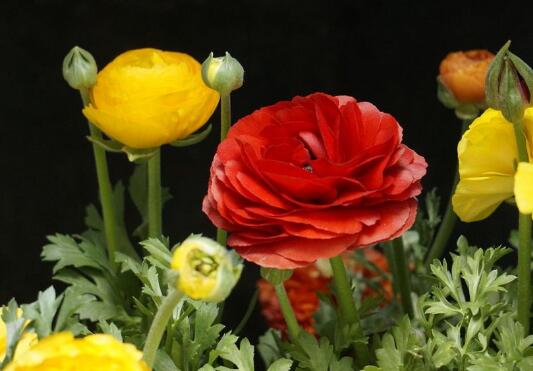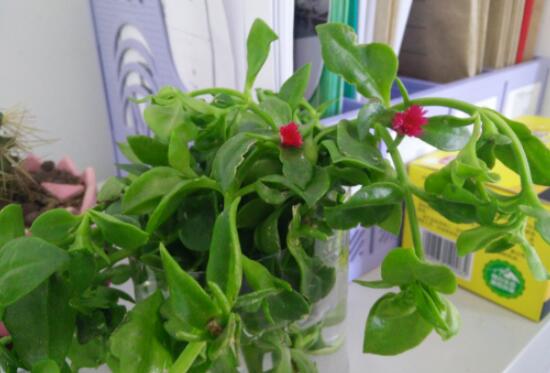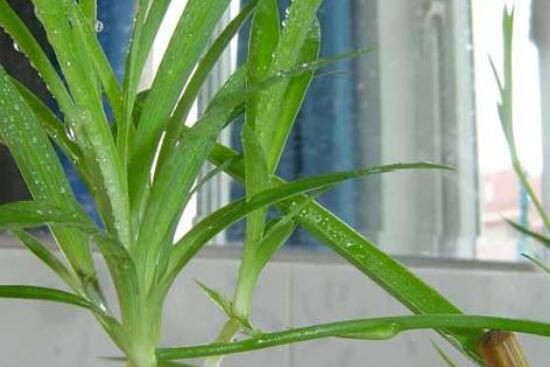How to maintain buttercups, breeding methods and precautions / avoid bright light
Buttercup is a world-famous flower plant, which is highly ornamental and is cultivated all over the world. However, if you want to keep it well, you still need to pay attention to a lot of things. About how to maintain buttercups, what are the breeding methods and precautions for buttercups? Next, the editor will take you to learn about it.
First, how to take care of buttercup and understand its habits

If you want to know how to maintain buttercup, we must first understand its growth habits. This plant prefers a cool and semi-shady environment and is less resistant to heat, so we should pay attention to temperature control in summer. In addition, the daily irrigation of water and fertilizer is also a point to pay attention to, the details are below, let's take a look at it.
2. Breeding methods and matters needing attention of Ranunculus
1. Slightly alkaline soil
Before we cultivate buttercups, we first need to choose soil, just like building a house and laying a good foundation. this is a step to lay a good foundation. generally speaking, it is best to choose neutral or alkaline soil that is loose, fertile and well drained. It can grow better on this soil.
two。 Fertilization, once every 10 days during the growing period
Fertilizer is an important nutrient in the growth process of buttercup, especially after entering the growing period, its demand for fertilizer is very high, basically every 10 days need to be fertilized. However, when fertilizing, we should pay attention to one thing, that is, the fertilizer must be diluted with water first. If the concentration is too high, it is easy to burn the plant.
3. Temperature, 20 ℃ during the day / 7: 10 ℃ at night
When we breed buttercup, it is very important to keep it growing at a suitable temperature. It is not only afraid of heat, but also afraid of cold. The suitable temperature is about 20 ℃ during the day and between 7-10 ℃ at night, so that it can grow better.
4. Moisture, avoid stagnant water
Buttercups can not lose water during the whole growing period. From budding to flowering, we need to keep them hydrated so that they can grow better, and after entering the flowering stage, they will have a higher demand for water. We should always keep the soil moist to ensure that its flowers are fat and bright. But the amount of water we need to control, be sure not to cause stagnant water, otherwise it will easily lead to root rot.
5. Light, avoid strong light
Buttercups prefer a cool and semi-shady environment and avoid strong light, so when we breed it, it is best to put it in a place of sunlight scattering, and when the light is strong in summer, we should move it to the indoor semi-shade to avoid burning the plant.
6. Diseases and insect pests should be dealt with in a timely manner
In the process of breeding buttercups, if we are not careful enough, it is easy to let diseases and insect pests enter. This kind of problem is very harmful to plants, so we must deal with it in time when we find it, because the longer it takes, the more difficult it is to deal with it. For specific treatment methods, you can refer to the article on pest control of Ranunculus, which is introduced in detail.
Breeding methods and matters needing attention of Ranunculus
Family breeding methods of Ranunculus
The family reproduction methods of Ranunculus are as follows: bulb propagation, plant propagation, sowing propagation and tissue culture propagation. When raising buttercups in the family, we usually use bulbs and ramets to propagate.
The requirement of sowing and reproduction is higher, which is more suitable for field planting and breeding, and for the mass reproduction of buttercup. Next, the editor mainly introduces the bulb root and ramet propagation methods of Ranunculus.
Bulb ramet propagation
The bulb ramet propagation method of Ranunculus can be said to be the most suitable method for family flower cultivation, which has the advantages of short growth cycle, early flowering, large flowering plant and more flowering, and the biggest advantage is easy cultivation.
The disadvantage is also very obvious: the ramet reproduction coefficient is low, the reproduction speed is slightly slow, and there is no way to mass-scale production, so it is only suitable for domestic flower friends.
The best time for ramet propagation is from September to October. Take out the root block of buttercup which is dormant in summer, remove the soil and break it along with the natural growth. Each piece should have a piece of root, and there should be a number of new buds and small roots.
Soak the root pieces in 1% potassium permanganate solution for 3-5 minutes for disinfection and sterilization, dry slightly before planting.
For the root of buttercup dormant in summer, in order to prevent the root from rotting and sprouting neatly, the root should be accelerated after disinfection: choose a shady, ventilated and sheltered place, spread a layer of clean wet sand with a thick layer of 5cm, insert the root upside down in the wet sand, only bury the root in the bud, and expose the rest.
Often spray cold water to keep the river sand from dry and stagnant water; at the same time, spray more than 50% Yinling wettable acne 800 times a week for disinfection to prevent root rot.
After slowly absorbing water and expanding at low temperature, about 20 days later, the buds sprouted like rice grains and new roots were planted. Planting should not be too deep, just bury the root and neck.
Too deep is not good for leaves; too shallow is not good for rooting. Control watering before emergence, keep the soil moist, and then gradually increase the amount of water after finishing the seedling.
Sowing and reproduction
Raising seedlings:
The normal sowing period of Ranunculus is from mid-October to mid-November. After putting the seeds in water for one day, the seeds are removed, wrapped in gauze, and then placed in a thermostat to accelerate germination. The appropriate temperature is about 15 ℃. Rinse with clean water once a day in the morning and evening, then drip water to keep the seeds moist.
About 7 days after germination, some of the seeds began to germinate, and the seeds could be sown immediately.
The seeds to be germinated are properly dried, mixed with appropriate amount of yellow sand, and then sown in flowerpots or courtyards. Mix peat and perlite at 1:1 with suitable thickness of 0.2~0.3cm.
The sowing and propagation of Ranunculus should be carried out in a well-drained soil and in an environment with good ventilation and light transmittance. Strengthen the protection of the sowing environment to avoid the threat of weather disasters and diseases and insect pests.
It usually takes a week to grow seedlings after sowing. At this time, it is necessary to keep the soil moist and replenish water in time to ensure smooth emergence.
Colonization:
When the seedlings of Ranunculus ranunculus grow to 3-4 true leaves, it will be planted from mid-December to mid-January.
Buttercup likes slightly acidic environment, so it is suitable to choose loose and fertile sandy loam.
Usually with garden soil, sandy soil, rotten cake fertilizer (chicken manure) according to the proportion of 5:3:1, or with the same soil, rotten leaf soil, rotten organic fertilizer at 4:2:1 proportion of the plant spacing of about 10cm, the depth of not burying the heart is appropriate.
Matters needing attention in the maintenance of Ranunculus
Buttercup is suitable to be planted in well-drained, fertile and loose sandy soil with a pH value of 6-7.5.
Buttercups like to be wet, afraid of stagnant water, afraid of drought. Do not lack water during planting, but do not get too wet, and avoid pouring water on the leaves, otherwise it will lead to disease.
Buttercups like sunny environments and cool climates, but the temperature should not be lower than 10 ℃ or higher than 25 ℃.
Buttercup likes fertilizer, pay attention to topdressing during the growing period, apply light fertilizer once every 10 days at the beginning, and then gradually increase the dosage and concentration with the growth of flowers and seedlings.
Buttercups bogey glare. Potted plants should be placed in a cool and cool environment to avoid drought, waterlogging and soot pollution, and always keep the potted soil and its surrounding environment moist.
For example, if the content of organic matter in basin soil is high, only once or twice before and after budding, the dilute liquid fertilizer dominated by phosphorus and potassium fertilizer is applied.
Cut off the residual flowers at any time after flowering, apply liquid fertilizer once or twice to raise roots, and properly control water to make them safely enter summer dormancy.
If the buttercup is planted in the courtyard, the row spacing is 15 cm ~ 20 cm. When potted, one ball can be planted in a small pot and two balls can be planted in a large pot. You can winter outdoors in warm areas, but indoors in cold areas.
The basin soil should be kept in a semi-dry state to prevent the corm from rotting.
During the peak growth period in spring, the soil should always be kept moist, but the soil should be slightly dry during flowering, and liquid fertilizer should be applied twice. The dormancy period should be entered in summer, and the bulb should be fully dried and placed in a ventilated and dry place after harvest, otherwise it is easy to rot.
How do you raise buttercups? Culture methods and matters needing attention of Ranunculus
Ranunculus is a perennial herb of Ranunculaceae with low and erect plant type and beautiful and colorful flowers. It has high ornamental value and is a famous ornamental flower. Nowadays, buttercup has become an indispensable indoor ornamental flower, deeply welcomed by consumers. So, how to raise buttercups? The breeding methods and matters needing attention of Ranunculus are introduced as follows.
Picture: buttercup
I. Culture methods of Ranunculus
1. Soil: buttercup prefers well drained, fertile and loose neutral or alkaline soil, and sufficient base fertilizer is applied when planting. Potted plants require sandy culture soil rich in humus, loose and fertile, and strong permeability. Two parts of garden soil, one part of rotten leaf soil and one part of barnyard manure can be used as basin soil.
two。 Lighting: buttercup can not tolerate strong light, prefer semi-shade environment, sufficient light in winter, moderate shading and ventilation should be strengthened with the increase of air temperature and light in spring. In addition, buttercup is a long-sunshine plant, and the flowering period can be controlled according to its characteristics.
3. Watering: buttercups like to be wet and afraid of waterlogging, more resistant to drought, but not too dry. Water should be fully watered for the first time after planting, and then watering should be timely and balanced, and should not be too dry and wet. The watering degree should be that the soil surface is dry and the leaves do not wilt.
Picture: buttercup
4. Fertilizer: before planting buttercup, organic fertilizer such as rotten cake fertilizer or animal manure should be selected as base fertilizer and spread evenly. After transplanting, topdressing began when the plant grew obviously or grew new leaves, mainly urea in the early stage and compound fertilizer in the later stage, applying once every 7 days.
5. Temperature: Ranunculus prefers cool environment, and the optimum growth temperature is 15-20 ℃ in daytime and 7-8 ℃ at night. The temperature should not be too high or too low, and the temperature difference between day and night should not be too large, otherwise the growth and development of buttercup will be affected, resulting in the decline of the number and quality of flowers.
6. Insect pests: buttercup growing period if high temperature and high humidity, easy to cause plant overgrowth, yellow leaves and stem base disease rot. The main pests are root maggots and leaf miners, which are sprayed with 1000 times of omethoate EC, and root rot is irrigated with 1000 times of 50% benzoate wettable powder.
7. Pruning: buttercup is a kind of flower plant with beautiful plant type and bright color, which grows rapidly. At the initial stage of budding, each plant is selected to leave 3-5 strong buds, and the rest is removed. At this time, the potted soil should be a little drier. If there is no need to leave seeds after flowering, the residual flowers should be cut off in time.
Picture: buttercup
Matters needing attention in Ranunculus Culture
Buttercup is suitable to be planted in well-drained, fertile and loose sandy soil with a pH value of 6-7.5. Ranunculus likes to be moist, afraid of stagnant water and afraid of drought. Do not be short of water during planting, but do not get too wet, and avoid pouring water on the leaves, otherwise it will lead to disease; buttercups like sunny environment and cool climate, but the temperature can not be lower than 10 ℃, nor higher than 25 ℃; buttercups like fertilizer, pay attention to topdressing during the growing period, apply light fertilizer once every 10 days at the beginning, and then gradually increase the dosage and concentration as the seedlings grow. Potted plants should be placed in a sparse and cool environment to avoid drought, waterlogging and soot pollution, and often keep the potted soil and its surrounding environment moist; for example, if the content of organic matter in potted soil is high, only apply sparse liquid fertilizer mainly with phosphate and potassium fertilizer once or twice before and after budding; cut off the residual flowers at any time after flowering, and then apply liquid fertilizer once or twice to raise roots, properly control water to make it safe to enter summer dormancy; if you plant buttercups in the courtyard, the row spacing is 15-20 cm. When potted, one ball can be planted in a small pot and two balls can be planted in a large pot. Warm areas can winter outdoors, but cold areas need to winter indoors; basin soil is required to maintain a semi-dry state to prevent corm rot. During the peak growth period in spring, the soil should always be kept moist, but the soil should be slightly dry during flowering, and liquid fertilizer should be applied 1-2 times. The dormancy period should be entered in summer, and the bulb should be fully dried and placed in a ventilated and dry place after harvest, otherwise it is very easy to rot.
[editor's conclusion] Ranunculus likes to be wet and afraid of waterlogging and is not resistant to strong light, so it needs special attention in the process of maintenance. The above introduces the breeding methods and matters needing attention of Ranunculus. Do you understand it?
- Prev

How to cultivate the peony orchid in water? the method of hydroponic culture / pruning and drying is inserted into the water.
As a powerful orchid, peony orchid not only has good-looking leaves and strong ability to absorb formaldehyde, but also can produce beautiful flowers. Compared with soil culture, many flower friends prefer water culture, can the peony orchid be hydroponically cultivated? If you can, how can peony orchids be hydroponically cultivated? The following is the hydroponic culture method of peony orchid.
- Next

How to deal with the yellowing of the leaves of the green orchid, learn 5 tricks to solve easily / water and fertilizer is the key
In life, many families will raise a pot of green leaf orchid, not only for its ability to absorb formaldehyde, but also to appreciate its beautiful leaves. So when there is something wrong with the leaves, such as yellowing, the flower friends must be in a hurry! So, what should I do if the leaves turn yellow? To this
Related
- Fuxing push coffee new agricultural production and marketing class: lack of small-scale processing plants
- Jujube rice field leisure farm deep ploughing Yilan for five years to create a space for organic food and play
- Nongyu Farm-A trial of organic papaya for brave women with advanced technology
- Four points for attention in the prevention and control of diseases and insect pests of edible fungi
- How to add nutrient solution to Edible Fungi
- Is there any good way to control edible fungus mites?
- Open Inoculation Technology of Edible Fungi
- Is there any clever way to use fertilizer for edible fungus in winter?
- What agents are used to kill the pathogens of edible fungi in the mushroom shed?
- Rapid drying of Edible Fungi

